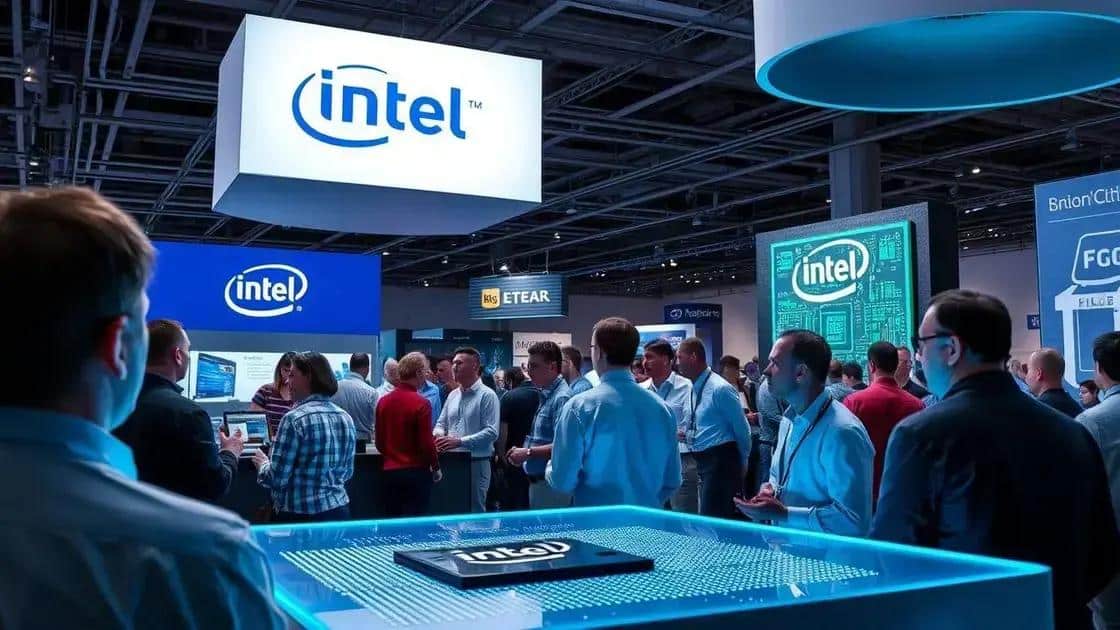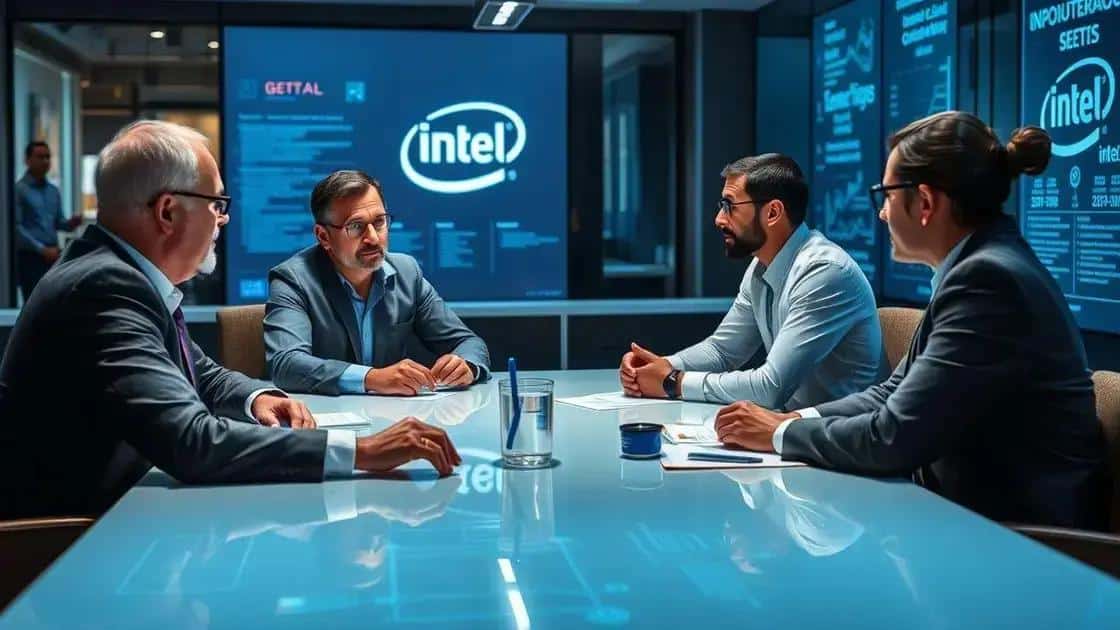Intel sells majority share in Altera business division

Anúncios
Intel sells the majority share in its Altera business division, impacting FPGA technology development and market dynamics by steering innovations in AI, cloud integration, and edge computing.
Intel sells majority share in Altera business division opens a new chapter in the semiconductor landscape. This strategic move has implications not just for Intel, but also for how technology evolves in various industries. Curious about what this means for the future?
Anúncios
Overview of Intel’s role in the semiconductor industry
Intel has been a cornerstone in the semiconductor industry for decades. The company’s innovations have not only shaped its own future but also influenced global technology trends.
In understanding Intel’s role, it is crucial to delve into its historical context and market impact. The company has continually adapted to changes in technology and consumer demand.
Anúncios
Key Contributions of Intel
Intel is renowned for pioneering various technologies that have become industry standards. Its commitment to research and development has resulted in significant advances.
- Development of microprocessors that power personal computers.
- Leading advancements in chip-making technology, including smaller transistors.
- Innovation in integrated circuits that integrate multiple functions onto a single chip.
These contributions have not only driven Intel’s success but have also propelled the entire semiconductor industry forward. Intel’s influence extends beyond just tech products; it impacts sectors such as healthcare, automotive, and even entertainment.
Market Position and Competition
Intel stands as one of the largest manufacturers in the world, often competing closely with AMD and other emerging companies. This competitive landscape pushes Intel to continually enhance its product offerings.
The firm’s strategic decisions, like the recent sale of its Altera division, reflect its ability to pivot in response to market needs, focusing on greater efficiency and innovation.
- Intel constantly revises its strategies to maintain market leadership.
- The company invests heavily in cutting-edge technology to stay ahead of competitors.
- Staying relevant in an evolving industry requires ongoing adaptation.
As we look ahead, Intel’s role will undoubtedly continue to evolve, influencing the semiconductor market and shaping the technology landscape for years to come.
Implications of the Altera sale for Intel’s strategy

The sale of Altera by Intel marks a pivotal moment in the company’s strategy. This decision not only affects Intel’s financial standing but also shapes its future direction in technologies like FPGAs (Field Programmable Gate Arrays).
With the divestiture, Intel seeks to refocus its resources and enhance its core semiconductor business. This move is crucial in a rapidly changing tech landscape where flexibility and innovation are vital.
Strategic Realignment
As Intel adjusts to this new reality, the company is aligning its focus on key areas that are essential for growth.
- Investing in artificial intelligence and machine learning technologies.
- Enhancing the development of 5G technology.
- Concentrating on the advancement of its foundry services.
This realignment aims to position Intel as a leader in emerging technologies rather than competing in crowded segments. Such a strategy allows the company to innovate and expand into more lucrative markets.
Financial Impacts
The financial implications of the sale are significant. By offloading Altera, Intel hopes to streamline its operations and improve profit margins.
In addition, this decision might lead to new partnerships that can drive future growth. With a sharper focus on core competencies, Intel is poised to enhance its competitive edge.
Overall, the Altera sale can be seen as a step toward more robust strategies that align with ongoing technological demands. As Intel navigates these changes, it remains crucial to monitor how this move impacts its overall market position.
How the sale affects Altera’s product lineup
The sale of Altera has significant implications for its product lineup. This transition is not just a change of ownership but also a potential shift in the direction of Altera’s innovations. Understanding these effects requires a closer look at how products are developed and marketed.
One of the primary areas affected is the focus on field programmable gate arrays (FPGAs). Intel’s previous investment in Altera fueled advancements in FPGA technology. With a new owner, there’s potential for renewed focus on innovation or possibly a re-evaluation of current products.
Impact on Current Offerings
As Altera moves forward, the portfolio might see some changes. Here are a few potential impacts on current offerings:
- New enhancements or features in existing FPGA products.
- Possible discontinuation of less popular products.
- Introduction of new product lines aligning with customer needs.
By streamlining its focus, Altera may enhance the quality of its offerings while also meeting changing market demands. This can create opportunities for innovation that were not possible under the previous structure.
Future Innovations
Looking to the future, Altera’s new management can decide to invest in emerging technologies such as artificial intelligence and IoT (Internet of Things). This could pave the way for a refreshed product lineup that appeals to broader applications.
As competition in the semiconductor industry intensifies, the ability to adapt and innovate becomes essential. Innovations in Altera’s product lineup can strongly influence their market position and capture new customer segments.
Overall, the implications of this sale will unfold over time, but it certainly marks a critical point for both Altera and its customers.
Future trends in FPGA technology and market competition

The future of FPGA technology is exciting and full of possibilities. As the demand for customizable hardware solutions grows, FPGAs will play a crucial role in the tech landscape. These devices offer flexibility and efficiency that can be tailored to specific needs across various industries.
In the coming years, we will likely see significant trends emerge in the FPGA market. These innovations will not only shape the technology itself but also impact how businesses approach hardware solutions.
Key Trends to Watch
Several key trends are expected to dominate the FPGA market:
- Increased adoption of AI in FPGA applications.
- Greater integration of FPGA with cloud computing technologies.
- Expansion into edge computing to meet low-latency demands.
- Enhanced power efficiency and speed in design.
As industries adopt AI and machine learning, FPGAs will be instrumental in accelerating data processing and decision-making capabilities. The combination of FPGA adaptability with AI will lead to powerful applications in sectors like automotive, healthcare, and telecommunications.
Market Competition Dynamics
With these advancements, competition in the FPGA market will intensify. Major players like Intel and Xilinx will strive to innovate faster, offering more advanced solutions to stay ahead. New entrants may also disrupt the market by targeting niche applications.
Companies will increasingly invest in R&D to enhance their offerings. This focus will drive not just performance, but also affordability, making FPGAs accessible to smaller companies and startups.
Overall, the future of FPGA technology is poised for growth, with trends driven by technological advancements and market needs that are continuously evolving.
FAQ – Frequently Asked Questions about FPGA Technology
What is FPGA technology?
FPGA stands for Field Programmable Gate Array, a type of reconfigurable hardware that can be programmed to perform specific tasks.
How does AI impact FPGA development?
AI integration in FPGAs allows for enhanced data processing capabilities, making them ideal for applications in machine learning.
What are the main trends in the FPGA market?
Key trends include increased AI adoption, cloud computing integration, and a focus on edge computing solutions.
How does market competition affect FPGA innovation?
Intense competition drives companies to innovate rapidly, resulting in improved features, efficiency, and affordability in FPGA products.






